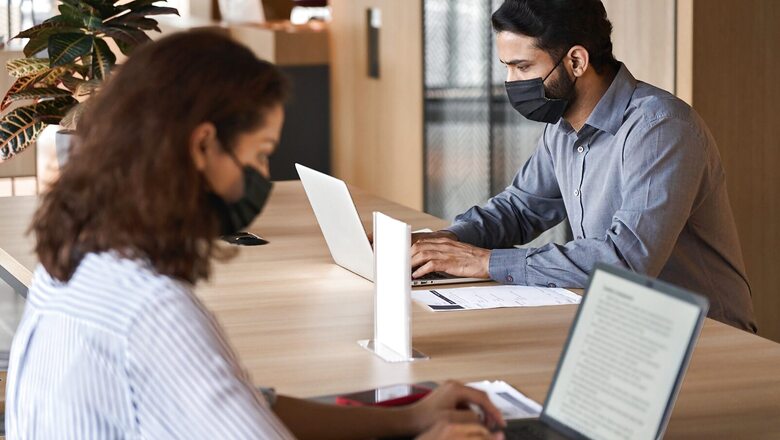
views
The ongoing COVID-19 pandemic has completely changed the work culture. There has been a fundamental shift in how people work now. Although the pandemic brought along with it death and destruction, it did accelerate the processes of decision-making in difficult and remote situations. Two years ago, no one would have imagined that large office spaces would be out-placed by work desks at homes and social gatherings would be replaced by virtual meetings globally.
Although it is almost impossible to predict when exactly the post-pandemic will be, normalcy is sweeping back and office spaces have started to function again. As employees are moving back to working from office, it is important to rethink and rework how workplaces should function. Safeguarding employees’ health and their overall well-being must be a priority. Although we have learnt to live with the virus, we are yet to achieve 100 per cent vaccination among the eligible population. But what we surely know about the pandemic is that it is highly unpredictable. As new things about the virus unfold, we should realise that only appropriate measures can keep people safe and ensure workflow is not interrupted.
Several employees in India have rethought their employment responsibilities and personal objectives after witnessing the blowback in the last two years. According to a LinkedIn survey released in January this year, 82 per cent of the Indian workforce is considering changing jobs. While switching, 30 per cent of those polled said they were looking for work-life balance. Over 70 per cent respondents have self-doubt about their working capabilities as a result of the pandemic’s devastating influence on their life. People are increasingly looking for occupations that will keep them physically and psychologically healthy. It is clear that people are now looking for more than just good money.
ALSO READ | Women@Work: Can the F-word Be a Game Changer for Women’s Employment in India?
Prioritising Employee Well-being
Employers need to radically think of solutions before bringing people back to office spaces fully. Employee well-being, both physically and mentally, reflects on absenteeism, their participation levels and overall productivity of the organisation. As employees return to on-site work, it is important to keep in mind that the past two years have been tough for all. During this period, employees have figured out their own mind space, routines and workarounds to get the job done. It is unfair to those who have adjusted their lifestyle around the ever-changing situation for their organisation, if their well-being and satisfaction are not taken into consideration.
Several research studies indicate a rise in mental stress among employees during the pandemic. With chances of substantive changes in lifestyle due to new working conditions, the stress can increase, leading to poor mental health. It, therefore, becomes the organisation’s responsibility to create flexible schedules and inclusive work spaces. The first important step is to understand what are the overarching challenges employees are facing that can lead to stress and anxiety. Activities like peer-to-peer exchanges can help in understanding the variance of stress among different employees. Encouraging open communication practices, support systems and lesser rigidity with an allowance for hybrid work are steps in right direction.
Future Workspaces Should Look Like…
There is no guidebook on how to run organisations post a long health emergency. However, there are some precautionary steps that can help in ensuring everyone’s safety. Two things that can help us in these volatile and evolving situations are adaptability and flexibility. Although new office constructions can accommodate new technologies to deliver these in future, the existing buildings can also do with some workaround.
First and foremost, there is need for better ventilation in office spaces. Centers for Disease Control and Prevention suggests proper ventilation: “When indoors, ventilation mitigation strategies can help reduce viral particle concentration. The lower the concentration, the less likely viral particles can be inhaled into the lungs (potentially lowering the inhaled dose); contact eyes, nose, and mouth; or fall out of the air to accumulate on surfaces.”
Another important point for consideration is the number of people working together in a single space, like persons per floor. It is important that social distancing is practised and masks are mandated wherever possible. Office spaces should be sanitated on a regular basis. All of these would help in reducing the possibility of spread of the virus.
Technological advancements have ensured that work continues even in the most challenging circumstances. Online work has opened opportunities that we never knew existed. But for many job roles, collaborative work in physical spaces is important. But a healthy life is as important as productive work output.
There is, of course, no one-size fits all approach. However, necessary precautions and steps by organisations will help. The past two years have been dark, but as cases are decreasing and vaccination rates are going up, there is a sense of light at the end of the tunnel. The only way we can close the gap and think of going back to the way (at least partially) we were functioning two years ago is by ensuring the well-being of all.
Mahek Nankani is Assistant Programme Manager at The Takshashila Institution. The views expressed in this article are those of the author and do not represent the stand of this publication.
Read all the Latest Opinions here

















Comments
0 comment